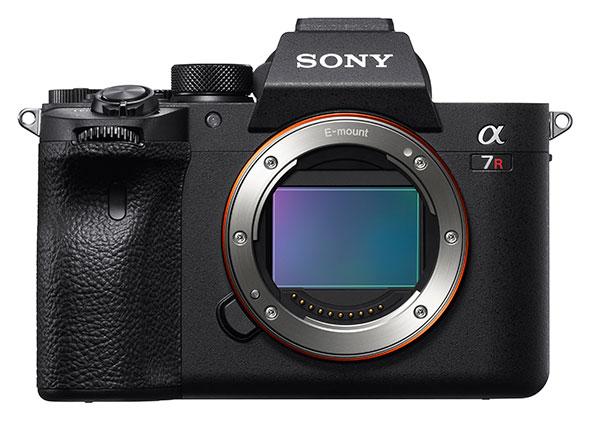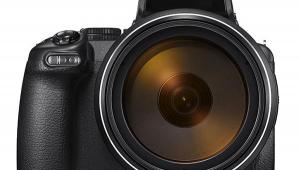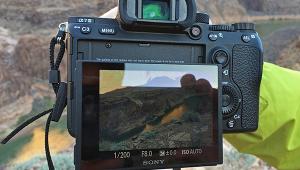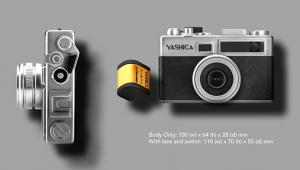Full Frame Digital Cameras: The Most Important Imaging Trend of the Past Decade

Full frame digital cameras have been a dominant force in the imaging marketplace for quite some time, and as we begin 2020 “the year of perfect vision,” mirrorless cameras have clearly surpassed DSLRs in terms of new product introductions and overall sales figures. The reasons aren't hard to fathom.
Mirrorless cameras can deliver a DSLR-like shooting experience and a more compact form factor, along with technical advantages that include full-time AF and AE during the exposure, enhanced responsiveness, a live view EVF that displays exposure and color corrections in real time, inherently less noise and vibration, and superior imaging specs for capturing high-speeds bursts and 4K video. Nevertheless, top high-end pro DSLRs, such as the Canon EOS-1D X Mark II featured here, can deliver comparable real-world performance while providing a reassuringly traditional form factor plus seamless compatibility with legacy lenses.
There are now scores of great digital cameras on the market spanning the format spectrum ranging from Micro Four Thirds to APS-C to medium format. But in the stunning variety of their form factors, conceptual uniqueness, technical ingenuity, and brilliant functionality, full-frame cameras are at the sweet spot. They definitely comprise the most rapidly expanding category within the mirrorless domain, and in the DSLR category as well. Indeed, it’s fair to say that more serious shooters and pros than ever before now aspire to own a full-frame digital camera.

What’s So Great about Full Frame?
Full-frame cameras piqued the interest of serious photographers over the past decade (and continue to do so today) because they have the potential of delivering superior image quality, especially at high ISOs and in sophisticated video applications such as recording in DCI and UHD 4K video at up to 60p. And, for any given angle of coverage, full frame cameras will typically use longer focal lengths than Micro Four Thirds and APS-C format models, providing shallower depth of field and enhanced depth of field control at any aperture.
The fact that full frame cameras also don’t have a multiplication factor when used with existing full frame lenses means that any older wide-angle lenses in your optical arsenal will deliver the full benefit of their wide-angle coverage.
Sony sparked the full-frame mirrorless revolution with its enormously successful Alpha 7 series, and the new flagship A7R Mark IV with its 61MP Exmor CMOS sensor and the sleek, compact 24.2MP Sony a9 II are striking examples of how they’ve evolved the category. The recently introduced 47.3MP Panasonic Lumix DC-S1R is another outstanding full-framer, as is the 24.2MP Panasonic Lumix S1H included here.

It’s also significant that Nikon and Canon both entered the mirrorless category with serious hi-res full-frame top-of-the-line models, the 45.7 MP Nikon Z7, and the 30.3MP Canon EOS R. Leica recently upped the performance ante with the formidable new Leica SL2 that incorporates a hi-res 47.3MP CMOS sensor coupled to its state-of-the-art Leica Maestro III Image Processor. The enthusiastic reception accorded the incredibly slim ultra-compact full frame Sigma fp is another harbinger of good things to come.
2020 will definitely be a banner year for digital full-frame fans, no matter which type of camera you choose. Meanwhile, the recently ended 2010s were certainly the decade when the full frame digial camera asserted its dominance.
To celebrate both occassions we’ve selected five great full frame models (both new and from the recent past) to whet your appetite and to give you a clearer picture of the latest advances in this expanding category. What will be the dominant imaging trend of the 2020s? Who knows. But one thing is for sure: full frame digital cameras aren't going away anytime soon.
Panasonic Lumix S1H

Aimed squarely at serious video shooters, the Panasonic Lumix S1H closely resembles its robust stable mate, the versatile Panasonic Lumix S1R, but it has a lower res 24.2MP full frame CMOS sensor coupled to an advanced Venus Engine Image Processor that enables it to record 6K24p video, and DCI/UHD 4K69p with 4:2:2 10-bit sampling, The Panasonic S1H can capture a very broad 14-stop dynamic range in stills and video, provides sensitivity settings from ISO 100-51200, and Dual Native ISO settings that prioritize either low noise or low sensitivity to deliver optimum video performance. It also provides a pair of gamma settings, V-Log and Hybrid Log Gamma (HLG) for optimizing the dynamic range in post-production, as well as picture styles, Cinelike V and Cinelike D, and an in-camera LUT to facilitate monitoring. Like the DC-S1R, it features an ultra-hi-res 5.76m-dot, 0.78x OLED LVF and in this case it’s complemented by a large, tilting 3.2 inch, 2.33m-dot Touchscreen LCD and a top 1.8-inch status LCD that can be used for reviewing setting when the camera is off. An internal heat-dissipating fan with an Auto setting prevents overheating in high throughput applications, enabling unlimited video recording times. Other features: an impressive 9 fps continuous burst rate with AF-S, or 6 fps with AF-C, a special High Resolution mode that can boost the effective resolution to 96MP by combining sequential images, 225-area Depth from Defocus (DFD) contrast-detection AF for quick precise focusing and tracking, built-in sensor-shift image stabilization that provides up to a 6-stop advantage in minimizing the effects of handheld camera shake with stills and video, Dual SD memory card slots and Bluetooth and Wi-Fi connectivity. It’s all built into a durable weather sealed magnesium alloy body.
Price: $3,998
Canon EOS-1D X Mark II

While its successor was recently announced, the Canon EOS-1D X Mark II has been perched at the pinnacle of Canon's EOS line for nearly four years, which is a lifetime in digital camera years. Yes, the Mark III version is coming in mid-February, but, for now, the 1D X Mark II remains the full frame champ. This remarkable DSLR combines state-of-the-art image processing with robust multimedia capabilities. Its 20.2MP full-frame CMOS sensor is integrated with advanced Dual DIGIC 6+ Image Processors to deliver a sizzling 14 fps full-res burst rate (16 fps in Live View) plus DCI 4K (4096 x 2160) video capture at up to 60 fps and 800 Mbps, plus Full HD at up to 120 fps for slow-motion playback. Its 61-point High-Density Reticular AF II and Dual Pixel CMOS AF systems provide 41 cross-type zones for enhanced focusing precision. A separate dedicated DIGIC 6 processor maintains impressive AF speed when shooting 4K video and at high framing rates. Other key features: a 3.2-inch 1.62M-dot Clear View II Touchscreen LCD monitor, 8.8MP Still Grab when shooting video, native sensitivity settings to ISO 51200 expandable to ISO 409600, built-in GPS, Dual CFast and CompactFlash memory card slots, and an advanced 360,000-pixel RGB+IR metering sensor integrated with the EOS Intelligent Tracking and Recognition AF system to enhance metering and tracking accuracy. It’s all built into a robust dust-and-weather-sealed magnesium alloy body with an Intelligent Viewfinder II pentaprism finder that provides comprehensive configurable readouts, and an integrated ergonomic grip.
Price: $5,499
Read our Canon 1D X Mark II review here.
Buy the Canon 1D X Mark II on Amazon here.
Sony Alpha A7R IV

Sony upped the ante with a new class leading super-high-res full frame sensor in the latest iteration of the A7R, solidifying its position as a top choice among pros. The Sony A7R IV’s high performance 61 MP full-frame Exmor R BSI CMOS Sensor is mated to a cutting edge BIONZ X Image Processor and Front-End LSI, This combo delivers an impressive 10 fps full-res framing rate, ISO settings of 100-32000 that can be expanded to cover an ISO 50-102400 range, and UHD 4K video capture at 30 fps in XAVC S format with S-Log3 Gamma as found in high-end Sony video cameras, plus HLG (hybrid Log Gamma) support. It can capture a 14-stop dynamic range and offers 5-axis SteadyShot INSIDE sensor-shift image stabilization providing up to a 5.5-stop anti-shake advantage shooting handheld still and video. Its sleek ergonomic body design incorporating an impressively realistic 5.76m-dot Tru-Finder OLED EVF, and a rear 3.0-inch 1.44m-dot tilting touchscreen LCD for convenient control when working at high and low angles. Other features include Pixel Shift Multi Shooting to create images up to 169.6MP, Fast Hybrid AF with 567 phase detection and 425 contrast detection points, in-body Wi-Fi and Bluetooth connectivity, dual UHS-II rated SD card slots, a USB 3.1 Gen 1 Type C Port, and a PC Sync Port. All this and more is built into a robust body with a magnesium alloy chassis and comprehensive weather sealing.
Price: $3,498
Read our Sony A7R IV review here.
Buy the Sony A7R IV on Amazon here.
Sony Cyber-shot DSC-RX1R II

The successor to the world’s first full-frame (24x36mm format) non-interchangeable-lens compact, Sony’s exquisitely made high-performance RX1R II sports a higher-res full-frame 42.4MP Exmor R CMOS sensor, a Variable Optical Low-Pass Filter to deliver optimum resolution and artifact suppression, and a fast, ultra-sharp 35mm f/2.0 Carl Zeiss Sonnar T* standard wide-angle lens that incorporates 3 aspheric elements to minimize chromatic aberrations and a 9-bladed diaphragm to enhamce its inherently artistic bokeh. Other high-end features include a hi-res 3.0-inch, 1,228k-dot Tilting LCD monitor, a 2.36 M-Dot XGA OLED Tru-Finder EVF, and a BIONZ X Image Processor that delivers 14-bit RAW image data, a maximum full-res burst rate of 5 fps, sensitivity settings to ISO 102400, and high speed AF, Full HD 1080p video capture at up to 60 fps and XAVC S Format. The DSC-RX1R II’s fast, precise Hybrid AF system provides 399 phase-detection points, its 120-zone auto-exposure system offers a multi-zone metering option, and it has built-in Wi-Fi with NFC and SteadyShot image stabilization.
Price: $3,298
Read our Sony RX1R II review here.
Buy the Sony RX1R II on Amazon here.
Nikon Z6

Nikon’s brilliant mirrorless full-framer is a sleek broad-spectrum compact aimed at anyone from emerging enthusiasts to seasoned shooters seeking a combination of high value and high performance. Based on a 24.5MP full frame FX-Format BSI CMOS sensor coupled to an advanced EXPEED 6 Image Processing Engine, this high-tech combo delivers impressive performance parameters including UHD 4K video at 30 fps with N-Log for capturing an enhanced dynamic range, 10-Bit HDMI output, an extended sensitivity range from ISO 50-51200, and an impressive full-res burst rate up to 12 fps. Other high-end features: a wide-diameter Z mount with short 16mm flange distances enabling the use of more compact wider-aperture Nikkor Z lenses, a 273-point Phase Detect AF System, built-in 5-axis VR image stabilization to minimize the effects of handheld camera shake, a 0.8x 3.6m-Dot EVF, a 3.2-inch 2.1m-Dot Tilting Touchscreen LCD, and a top panel Dot-Matrix OLED display that allows easy monitoring of settings when the camera isn’t at eyelevel. The stylish Z6 provides a XQD card slot, and comes with an FTZ mount adapter allowing the direct use of legacy F-mount lenses and full functionality with E-, G-, and D-type Nikkor lenses. It’s all built into a rugged, weather-sealed magnesium alloy body.
Price: $1,697
Read our Nikon Z6 review here.
Buy the Nikon Z6 on Amazon here.
As an Amazon Associate, Shutterbug earns from qualifying purchases linked in this story.
- Log in or register to post comments
















































